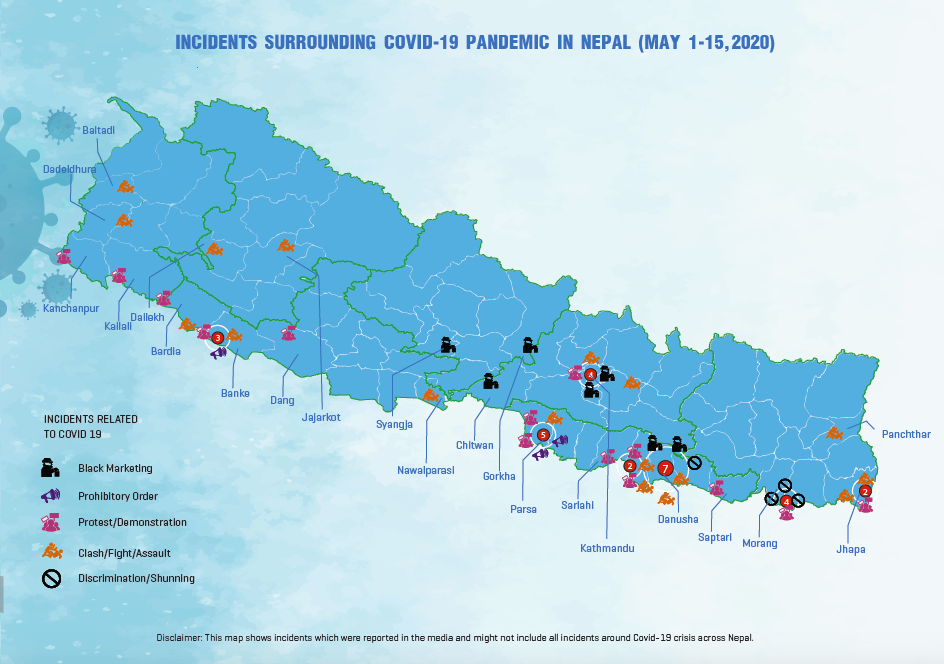Incident Reports
Number of child workers in brick kilns alarming
2016-06-14
A study conducted by Child Development Centre, a non-government organisation working for child rights, showed that there are more child labourers in brick kilns of Lalitpur than adult workers.
The study said a total of 974 children work in 28 brick kilns in Lalitpur, while only 804 adult workers are employed there.
Memo submitted to PM Oli
CDC had conducted the study on 108 brick kilns in the Kathmandu Valley, 62 of which were in Bhaktapur, 28 in Lalitpur, and 18 in Kathmandu through December, 2014 to January, 2015.
The study showed 1,550 children and 1,761 adults worked in 62 brick kilns in Bhakatpur, and 740 children and 531 adults in the 18 brick kilns in Kathmandu.
The workers come from 45 districts of the country, with most labourers coming from Kavre, Ramechhap, Sindhuli, Dang, and Rolpa.
Speaking at a programme organised here today by CDC in coordination with Nepal Journalists Forum, Child Rights Activist and Programme Director at CDC Kiran Thapa said children in brick kilns lacked daycare and sanitation facilities, were deprived of school education, and adolescents lacked supervision and could openly drink or smoke.
“In most cases, children accompany their parents to work in the brick kilns, and children who are fourteen and older come with people from their villages,” Thapa said, adding, “Because the wage is based on the number of bricks produced, parents bring their children with them to help them produce more.”
A rapid assessment conducted by World Education and Plan International Nepal in 2011 had stated that there were more than 750 brick kilns in Nepal that employed almost 200,000 workers, of which 16 per cent were children.
Thapa further said, “A decade ago there were a total of 2.6 million child labourers in various sectors, and through various initiatives taken by INGOs and NGOs, the number now stands at 1.6 million.
But our work will not end until all children are rescued from all forms of labour and exploitation.”
President of Brick Clean Network Surendra Dhakal said some brick kilns had banned the use of child workers, an initiative that according to him, the government should promote. Dhakal said, “We have urged the government to boycott bricks produced through child labour in reconstruction projects.”
Director General of Department of Labor Kedar Bahadur Bogati expressed his commitment to end child labor in the country.
The CDC had organised a huge rally from Bhadrakali to Shantibatika, and collected signatures for a petition to end child labour and submitted it to the labour minister.
Editorial...................................
Arecent report on the status of domestic child labour in Kathmandu says that in the last 15 years, the number of children working as domestic help in the Capital has decreased from one in five households to one in 20 households. The study conducted by the Children and Women in Social Service and Human Rights attributed the decline to an increase in awareness and a shift from domestic help to other forms of labour.
However, this semblance of progress belies a harsh reality. According to data from the Ministry of Women, Children and Social Welfare, the country has 1.6 million child labourers, 20 percent of whom are involved in perilous work such as mining and construction. But the abstract numbers do not tell the whole story. There are varying estimates of the number of children forced to work in different sectors. A report by the World Education and Plan Nepal titled ‘Rapid Assessment of Children in the Brick Industry in Nepal 2012’ put the number of child labourers in the brick kiln industry at 28,000. The carpet industry employs around 10,000 children as per UN estimates.
Then there is the issue of child trafficking. The International Labour Organisation (ILO) estimates that about 12,000 Nepali children are trafficked to India every year.
The aggregate impact of child labour in its various forms has a deep and lasting effect on the psychology of children. Child labour is not a one-off episode; every day, every month and every year, children are forced into employment both because of poverty and demand for cheap labour.
The country has the Child Labour (Prohibition and Regulation) Act 2000, which prohibits employing children below 14 years in any kind of labour and children below 18 years in hazardous work. The Act states that persons found forcing children below 16 years in labour could face a jail term of up to one year and a fine of up to Rs50,000.
Five years ago, the government had proposed a master plan with the goal to end the worst forms of child labour by 2016 and all its forms by 2020. The ambitious plan had envisioned, among other things, identifying child labour, setting a criteria for hazardous work and offering economic assistance and scholarship to the children of the poor. It had also proposed rehabilitation programmes for rescued child labourers, while building cross-border networks to combat child trafficking.
However, laws and plans without the will to implement them are hollow and do little to protect children. It is high time that the master plan was endorsed and implemented. We have missed the 2016 timeline, but it is not too late to end all forms of child labour by 2020.
National/Online Media
Related Reports
GBV / Siraha
Complaint lodged against a 30-year-old man on the charge of raping a 13-year-old teenage girl in Siraha
December 26, 2023
GBV / Okhaldhunga
52-year-old man arrested on the charge of sexually assaulting a 16-year-old teen girl in Okhaldhunga
Province 1, Okhaldhunga, Sunkoshi, Ward 8
December 03, 2023
GBV / Rupandehi
Complaint lodged against a 22-year-old youth on the charge of raping a minor girl in Rupandehi
August 29, 2023
GBV / Sudurpashchim
School teacher accused of sexually abusing students accused in Kanchanpur
August 20, 2023
Related Trend Analysis
Analysis

THE NEPAL PEACE MONITOR ANNUAL REVIEW: 2020
October 25, 2021
Human Trafficking / LGBT+ Rights / GBV / Political / Children’s Rights / Senior Citizens’ Rights / HRD Issues / Human Rights / Interpersonal Violence / Governance / Covid-19 / Civic-Space / PwD



